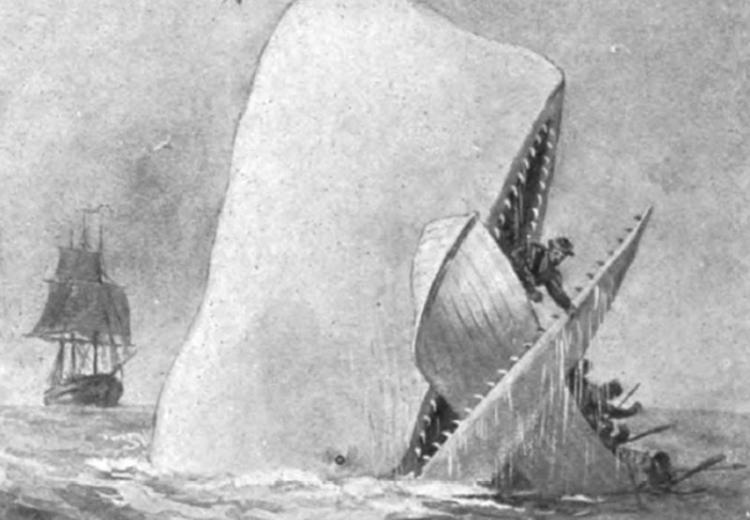Melville’s Moby Dick: Shifts in Narrative Voice and Literary Genres

Illustration from an early edition of Moby-Dick, 1892.
"The novel is an encyclopedia of forms, a narrative chowder that combines dictionary, whaling manual, comedy, tragedy, epic, prophecy, sermon, soliloquy, drama, bawdy humor, and tales within tales. … Melville looks at the whale, with relish, from an exuberant assortment of literary angles, encompassing them all into one mighty compendium and in so doing breaking the boundaries of what it means to be a book."
—Elizabeth Renker, Introduction to Moby-Dick
Moby-Dick, by Herman Melville, is widely recognized as one of the centerpieces of the American Renaissance. This text is more than a chronicle of Ahab’s quest for the great white whale, the novel offers insight into the whaling industry that shaped the New England seacoast in the 19th century. Melville himself spent time at sea and fashioned many of the details in Moby-Dick after his own experiences traveling aboard a whaling vessel in the South Pacific. Though seldom praised during Melville’s lifetime, Moby-Dick remains relevant today, as it helps builds our perceptions of America’s unique literary culture.
This unit is a study of the shifts in narrative voice and literary genres that Melville makes throughout Moby-Dick. It serves to introduce students to several unique features of the novel without demanding as much class time as would reading the entire text. The lessons comprise a series of close readings of passages from the novel.
Lesson 1 has students explore Melville’s development of his first person narrator Ishmael through a close reading of chapter 1. Students will consider Ishmael’s positioning of the Fates in the novel and the extent to which this positioning makes a narrative shift necessary to understand the perspective of other characters.
The next two lessons serve to orient students to several of the genres in this novel. Lesson 2 has students perform a close reading dramatic script as it surfaces in chapter 37 to examine Melville’s characterizations of Ahab as a foil to Ishmael. Students then analyze the shifting perspectives on character that this chapter elicits within the novel, and delve deeply into Melville’s complex protagonist—the multifarious character of Captain Ahab.
Lesson 3 guides students through examples of Melville’s seamless integration of several literary genres—hymn, sermon, scientific writing, and drama into the novel. It moves into an analytical discussion of Moby-Dick as a masterwork that goes above and beyond the appeal of its fictional genre.
Guiding Questions
How does Melville shift the focus of narrative voice from Ishmael to Ahab in Moby-Dick?
How does the narrative voice shift impact the reader’s understanding of Ishmael’s journey and of Ahab’s quest for the White Whale?
How does Melville use a variety of literary genres within the novel, Moby-Dick?
Why does he make these genre shifts?
What function do they serve?
